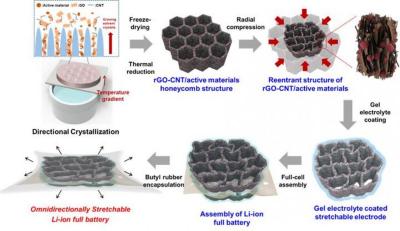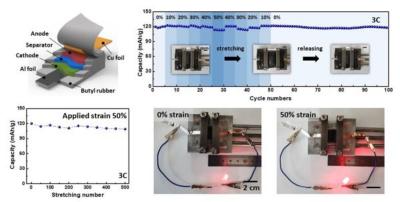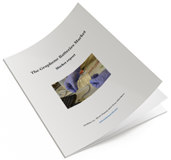Graphene batteries: Introduction and Market News - Page 22
Nanotech Energy concludes $27.5 Million funding round and announces non-flammable battery ready for commercialization
Los Angeles-based Nanot ech Energy has announced the official close of its Series C round of funding. This round was expected to close at $25 million, yet included an option to allow for an additional $2.5 million for a total of $27.5 million invested.
ech Energy has announced the official close of its Series C round of funding. This round was expected to close at $25 million, yet included an option to allow for an additional $2.5 million for a total of $27.5 million invested.
This round of funding with such high-level and committed investors validates the need the international market has for our proprietary battery technology, said Dr. Jack Kavanaugh, chairman and CEO of Nanotech Energy Inc. We are confident that we have a one-of-a-kind, industry-changing product that will impact the technologies and bottom lines of multiple end-user markets. This round of funding allows us to dramatically expand our production of graphene batteries, as well as our production of conductive epoxies, conductive inks and electromagnetic interference shielding spray paints and films. This will also facilitate our efforts to further increase our large-scale manufacturing of high-quality graphene that we provide for use in downstream applications.
KIST researchers develop stretchable graphene-based lithium-ion battery
A research team from the Korea Institute of Science and Technology (KIST) recently developed a graphene-based lithium-ion battery that is flexible enough to be stretched.

Dr. Jeong Gon Son's research team at the Photo-Electronic Hybrids Research Center at the Korea Institute of Science and Technology (KIST) developed the high-capacity, stretchable lithium-ion battery. The battery was developed by fabricating a structurally stretchable electrode consisting solely of electrode materials and then assembling it with stretchable gel electrolyte and stretchable packaging.
GAC to mass produce graphene-enhanced battery for EVs by the end of 2020
Chinese EV maker Guangzhou Automobile New Energy (GAC) has announced that it has developed a graphene-enhanced battery for EVs which will be available for mass production at the end of this year.
GAC reports that its graphene technology can charge batteries up to 85% in 8 minutes.
Stretchable Li-ion battery enhanced with graphene and CNTs to benefit wearable electronics
Scientists in the Korea Institute of Science and Technology (KIST) have worked with graphene and carbon nanotubes to develop a working lithium-ion battery that can be stretched by up to 50% without damage to any of the components. According to the scientists, the battery represents a significant step in the development of wearable or body-implantable electronic devices.

Rather than trying to add inherently stretchable materials such as rubber to the battery components, the group focused on creating an accordion-like structure, adding stretchability to materials that are not inherently stretchable. Using graphene and carbon nanotubes, the scientists were able to construct a honeycomb-shaped composite framework, which was then compressed inwardly like an accordion to impart the stretchable properties.
Graphene-Info updates all its graphene market report
Today we published new versions of all our graphene market reports. Graphene-Info provides comprehensive niche graphene market reports, and our reports cover everything you need to know about these niche markets. The reports are now updated to April 2020.
The Graphene Batteries Market Report:
- The advantages using graphene batteries
- The different ways graphene can be used in batteries
- Various types of graphene materials
- What's on the market today
- Detailed specifications of some graphene-enhanced anode material
- Personal contact details into most graphene developers
The report package provides a good introduction to the graphene battery - present and future. It includes a list of all graphene companies involved with batteries and gives detailed specifications of some graphene-enhanced anode materials and contact details into most graphene developers. Read more here!
Mercedes-Benz develops battery based on organic cell chemistry, graphene and a water-based electrolyte
Mercedes-Benz has reportedly created a compostable battery using organic cell chemistry, graphene and a water-based electrolyte. The battery is free of rare-earth and toxic metals, which means it can biodegrade without polluting the environment.
Mercedes-Benz' head of battery tech, Andreas Hintennach, said that while the tech is very promising, "we don't see that it's close to being used in production technology for now... It's around 15-20 years away."
Significant Market Opportunities for Graphene in Energy Storage
This is a sponsored post by Dr. Alex Holland, IDTechEx
Graphene has been heralded as a wonder material for years, with many believing a tipping point is rapidly approaching. It undoubtedly has the potential for use in numerous applications with one of the most notable being the energy storage market. Li-ion demand for plug-in electric cars alone is forecast to be nearly 350 GWh by 2025. IDTechEx forecasts that over 30% of the graphene market will be used in energy storage applications within the next decade with multiple high-profile use cases; see IDTechEx’s reports Li-ion Batteries 2020-2030, and Graphene, 2D Materials and Carbon Nanotubes 2019-2029 for more details.

One of the most significant technological developments in energy storage regards the use of silicon dominant anodes in Li-ion batteries. The theoretical capacity of silicon is around 10x that of graphite and has therefore been the topic of intense activity in the Li-ion market - Over $500 million has been invested in silicon anode start-ups alone since 2015. However, the material is plagued by one major issue: when lithiated, it can expand in volume by 300%. This causes various issues around loss of electrical connection between electrode particles and decomposition of the electrolyte, which ultimately leads to poor cycle life.
NanoXplore announces CAD$25,000,000 bought deal private placement
 NanoXplore recently announced that it has entered into an agreement with Echelon Wealth Partners to raise, on a bought deal private placement basis, approximately CAD$25,000,000 (around USD$17.6).
NanoXplore recently announced that it has entered into an agreement with Echelon Wealth Partners to raise, on a bought deal private placement basis, approximately CAD$25,000,000 (around USD$17.6).
The Company intends to use the net proceeds of this raise to support sales and marketing of graphene, research initiatives particularly related to the use of graphene in Li-Ion batteries, U.S. expansion, working capital and general corporate purposes.
Graphene Flagship partners produce environmentally-friendly graphene inks
Graphene Flagship partners Trinity College Dublin, Ireland, CIC EnergiGUNE and INCAR-CSIC, Spain, have produced rechargeable batteries and energy storage devices made of a non-toxic and environmentally friendly graphene-based material.

With current metal-ion batteries reaching their theoretical limitations in terms of cycle life, capacity and power, researchers focused on metal-air alternatives, such as sodium-air (Na-O2) batteries.
Tuning the interlayer spacing of graphene laminate films yields extremely efficient supercapacitors
Scientists from University College London and the Chinese Academy of Sciences have proposed a graphene-based design for supercapacitors, which reportedly increased their density by 10 times.
Supercapacitors charge quickly but also discharge at a high speed. Existing supercapacitors tend to have a low energy density about 1/20 of the battery capacity. Batteries combined with supercapacitors are already in limited use for example, in Chinese public transport. But the bus in which such a battery is installed is forced to charge at almost every stop.
Pagination
- Previous page
- Page 22
- Next page


